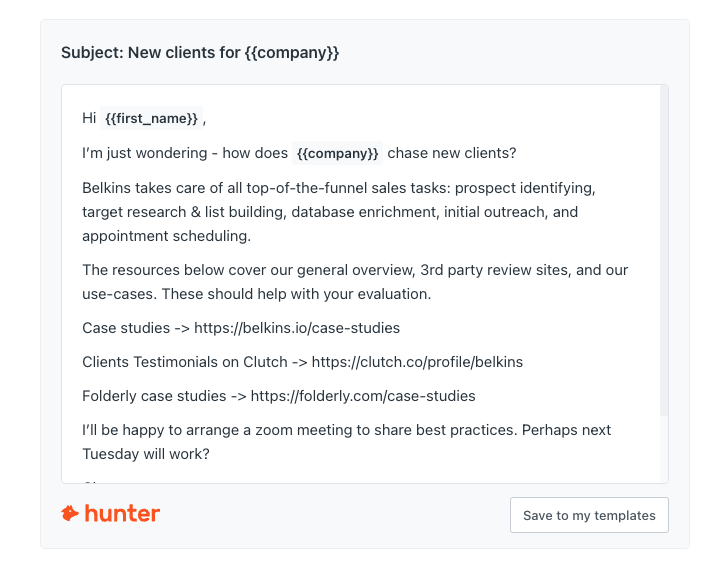How to Get More Clients for Your Business (9 Strategies)

Behind every successful business is a solid strategy for finding and attracting new clients. Having well-defined tactics for getting more clients is how you reach new goals, evolve your company the way you want to, and – sometimes – simply keep the lights on.
Even if you have prospective clients knocking down your door now, you need a plan for when you hit a slow patch or if you are planning to scale up.
In this post, we’ll cover nine different strategies that can help you get more clients for your business. Let’s get started.
1. Ask for referrals
When you need to attract new clients, the first place you should go is your current customer base. Your network can be your greatest strength, especially when you have happy clients who would love to shout your praises from the rooftops.
There are two main ways your network can help you: by providing direct referrals to your business or testimonials that you can use in your marketing efforts.
Getting referrals from your current clients, past colleagues, or others in your network gets easier when you make it easy for others to refer you.
The first step is to develop a template you can personalize for different audiences. Here’s an email template example you could use with one of your best clients, who you think would be happy to refer you:
Hey {Name},
I hope you’re doing well! Wanted to send a quick email to say that we’ve really enjoyed working with you, and we’re looking forward to continuing to work together. If you feel the same, I wanted to ask: Would you be open to referring us for new opportunities if you hear of them from friends or colleagues?
We’d love to help other businesses see some of the results you have. And since we work so well together, we figured you might know others with similar goals or challenges.
Thank you in advance for thinking of us. We really value our relationship and are grateful for it!
Thanks again,
{Your name}
2. Partner with other businesses
Another method of getting more clients would be to develop strategic partnerships with other companies. For B2B businesses, that might mean finding a company specialized in a similar service that can help you expand your offerings to clients.
If you’re a marketing agency, you might want to partner with a videographer to add well-produced videos to your list of services.
If you’re an SEO agency, maybe you team up with a web development firm so you can pitch a more comprehensive solution in new client meetings and proposals.
Working with another business that has a similar target audience but isn’t a direct competitor expands what you can bring to the table for clients. It can also be a way to bring in new clients.
When an RFP for an integrated digital campaign comes your way, you can reach out to your videographer contact and include them in your pitch.
The reverse is also true. That videographer might hear of an opportunity, but they need your agency expertise to pull it off.
This mutually beneficial relationship allows you to take on more work without adding more overhead or full-time staff. You can scale up and down on a project basis, and you might be able to pitch more clients.
Ready to strike a new partnership? Start by making a list of businesses that would be good potential partners.
Then, use Hunter’s Domain Search to get the relevant email address for every business you want to reach.
Once you have a list of the companies to contact and their email addresses, you can start reaching out to explain your offer and see if they would be interested in exploring a potential partnership.
3. Reach out to potential clients
If you’re scared of cold outreach or think it won’t be a successful way to find clients, might we suggest looking at what Belkins accomplished?
The lead generation firm landed a six-figure deal and saved 25 hours per month using Hunter to launch a cold email campaign.
The company defined an Ideal Customer Profile (ICP), used Google Maps to find the right buildings for their products, and then took advantage of Hunter’s Domain Search to find the email addresses of decision-makers directly at the companies they identified.
From there, a personalized email template got them in the door. It’s an ingenious way to get to the inbox you’re after.

Sounds pretty great, right? If you’re ready to try cold outreach, here’s an example workflow you can use.
- Find potential clients using Google search, Linkedin search, or TechLookup.
- Find email addresses using Email Finder or Domain Search, as we mentioned above.
- Create templates and send automated emails using Hunter Campaigns.
When drafting your campaign emails, make sure to save a template to speed up the process down the road. With Hunter Campaigns, you can fully personalize emails and then schedule when you want them to be sent.
You can send cold emails through your own email address, so your recipients only see a personalized, 1-to-1 email in their inbox. That can help cold outreach feel a little less…cold.
4. Join relevant Facebook groups
Today’s version of, “There’s an app for that,” is, “There’s a Facebook group for that.”
Over the years, Facebook groups have become much more targeted with their own well-defined purposes and niches, and sets of rules to follow. This is a good thing.
Gone are the days of mass publishing, where your brand’s organic post might reach its audience, or it might get buried in the timeline.
You can scour Facebook for dedicated groups created for your industry, your target client’s interests, and more.
Simply log in and start searching around your audience’s focus areas.

When using Facebook groups for finding clients, you’ll again want to go where your target audience is. Once you’re in, there’s a lot you can learn about your audience by first listening before you start posting.
Some Facebook groups are heavily moderated, so you’ll want to read all the rules and expectations and understand how others behave before you start spamming the group.
A good rule of thumb when it comes to groups is to follow the lead of the posts with the most engagement.
Start scrolling around until you find a post that a lot of people liked, commented on, or shared. See what they responded to and try to emulate that.
If the group allows an introduction or new member post, use it as a light sales pitch that feels hyper-relevant to the group.
Anything overt will come across as sales-y, but if you can quickly capture the benefits your business offers, you’ll stand out to those looking for just that.
One of the best ways to create connections in these groups is by answering questions from others and having a consistent presence.
If your ideal customers ask questions related to your expertise, don’t hesitate to jump in and offer some advice. Here, it’s not about selling your product or services, but showing that you have knowledge and experience in the topic they’re inquiring about.
Over time, you’ll be seen as an authority on the topic, and you might have prospects reaching out directly.
For group members you’re especially interested in talking to, you could send LinkedIn invites or use Hunter’s Email Finder to get their email addresses.
Participating in the same Facebook group can be a good entry point to a conversation, especially if you’re active and offering value.
5. Start a blog
We could go on and on about the benefits of starting a blog if you don’t have one already. You definitely don’t want to start a blog if you hate ROI, customer engagement, and lead generation.
A blog can help you build thought leadership and authority and attract potential clients when done correctly. Most businesses use their blog to share educational content that shows their audience how they can help solve important pain points.
The Harvard Business Review explains, “It is critical that the content your team produces is “outcome-based,” in that it focuses on the problems clients are facing rather than the products that the field is selling.”
The easiest way to get started is to identify topics your audience is interested in that align with what your company does.
Say, for example, you’re a service business that provides a fast, easy way to pay people internationally.
Your initial topics would be about the problems that you help online business owners solve, such as how to spend less time sending payments, how to calculate and compare currency conversion rates, and finding payment processors for the countries you’re sending money between.
Your blog shouldn’t be so focused on your business. Instead, it should serve up educational resources that your customers want. That’s how they’ll find you and discover your brand.
6. Write guest posts
You don’t have to keep all of those great insights to yourself. Pitching guest posts on other websites is another great way to get in front of customers. This is especially true if you find other sites that share your audience.
To get started, think about the type of blogs that would make the most sense for you to contact. These should be sites within your industry or that speak to your prospective customers.
If you’re a software startup, you can start with your integration partners. These are companies that you know target your audience. Plus, there might be a better chance of a content collaboration if you already have a contact there.
Then, you’ll need a list of topics to pitch to them. Again, these articles should offer helpful advice instead of a sales pitch, though you might be able to mention your company and include a link.
Every site is different, so it’s essential to check their requirements before you start writing once they agree to a guest post.
Securing a guest post is about both quantity and quality. You’ll need a wide range of sites to contact and a great pitch.
Once you have your list of blogs, you can use Hunter’s Domain Search or Email Finder tools to get the right email addresses.
Then, create a campaign in Hunter Campaigns to automate your outreach. Checking campaign stats can show you how effective your emails are, so you can make some changes if you’re not getting the engagement you want.
7. Host a webinar
Hosting a webinar is another great channel for acquiring your ideal clients because it can help you build trust and authority with prospects. Webinars are all about educating customers on solutions that can help with their biggest challenges.
Like blog posts and guest posts, try to avoid making webinars all about your product or solution. This is about genuinely educating your audience and establishing a connection.
If you’re sensing a trend here, you’re right! Using content to get new clients is all about delivering value.
Here’s a simplified workflow you might try out for your first webinar:
- Plan out your webinar and choose the topic
- Promote it and gather sign-ups
- Host it live by yourself or with a guest speaker
- Send out a recap soon after
- Follow up with a nurture sequence that shows how your business can help
These tips can help you get more value out of your webinar:
- Start by promoting the webinar to your email list.
- Create an email sequence to send out to attendees after the webinar that highlights key points.
- Create a video from the webinar that you can use as a lead magnet after the fact to continue building your audience.
- If you choose a co-host, ask them to promote the webinar before and after.
The greatest thing you can do once your webinar is over is to stay in contact with the attendees. Do you have a new feature they might want to know about? Can you send a case study that shows them exactly how to act on what they’ve just learned?
Your follow-up nurture emails should focus on bottom-of-the-funnel content aimed at getting them to sign up or buy. This is where you can ditch the awareness approach and go for the sales pitch.
If they watched the webinar and are still opening emails, that’s a good sign that they’re interested in what you have to offer. Don’t throw away the opportunity.
8. Attend industry conferences
For making personal, 1-to-1 connections, it’s hard to beat a good old-fashioned conference. The key here is to find conferences your target audience attends, not just ones for your industry.
Here’s what we mean:
If you’re a digital agency owner, you'd likely attend a conference on running an agency, fostering creativity, or planning for the future of advertising. But if you’re after potential clients, you’ll want to go where they are.
Say you’re looking to specialize in dental office marketing. You’d set up shop at a conference for dentists so you can get in front of them and connect over their marketing challenges.
Some conferences offer speaking opportunities or sponsorships, or sometimes both. However, you can also just attend and meet people that way.
One crucial part of finding new clients at conferences is to reach out before the event and establish a connection. You can find attendees on social media who have engaged with the event’s posts or are following the conference’s account.
If the attendee list is open, even better. Hunter can help you find conference attendee emails based on the company or if you have the person’s full name.
From there, send them a message saying you’re excited about the conference and wanted to see if you could meet up once you’re there.
Keep it highly relevant and valuable for your audience and let them know what they stand to gain from talking with you.
9. Create an online course
Creating an online course is another great way to get more clients for your business.
To maximize your reach, you can create your online course once and publish it on your own site or on different platforms, including Udemy and Skillshare.
Great online courses showcase a brand’s expertise, educate the audience, and attract potential clients. They can be targeted, like how to use your product, or they can be general courses related to your subject matter expertise.
Let’s go back to the videographer example: You could create a course on how to film senior leadership and create a whole video during one company retreat.
Online business owners who have complex products or services could create a course that walks through exactly how to use their solution in practice with on-screen tutorials and examples.
If you create accounting software, you might want an online course on preparing your small business taxes and organizing your bookkeeping ahead of tax season.
You can show all the ways that your software helps with this, solidifying both that you have the features they need and that you understand which parts of the process cause the biggest headaches.
Online courses can be free or gated, which means they’ll require someone to hand over their email address in order to gain access. Once you have that email address, make sure to follow up and continue engaging with helpful resources.
Start generating clients on autopilot
If you’re ready to start bringing in new business on a consistent basis, try implementing some of these strategies today. To recap, here are the nine strategies you can use to get more clients for your business:
- Asking your network for referrals with manual or automated email campaigns
- Partnering with other businesses that can support what you do
- Sending cold emails to potential clients
- Joining Facebook groups to improve your connections and reach
- Creating a blog that addresses customer pain points and provides solutions
- Guest blogging on other websites
- Hosting a webinar to establish trust and authority
- Attending industry conferences that your potential clients go to
- Creating an online course to build authority and reach new customers
Once you get started, be sure to check in on your different channels often so you can identify where to spend more time and which ones aren’t the best fit for your audience.
Soon enough, you’ll start to see certain tactics emerge as higher converting or with a better ROI than others. Those are the ones to focus on – they’re your best pathways to new clients.
Interested in learning more? Check out these guides:
- The Complete Guide to Getting Started with Cold Email
- 14 Sales Pitch Examples: How to Create a Sales Pitch That Converts
- 13 Essential Business Development Tools for 2022




 Send cold emails with Hunter
Send cold emails with Hunter